Project Overview
Beginning in January 2022, University Initiatives & Policy partnered with Life & Work Connections to expand lactation spaces on Tucson Main Campus and at other university locations throughout Arizona. Funded as part of President Robbins’ family-friendly initiatives, this effort has resulted in 16 new lactation spaces – increasing the current state-wide count to over 35 campus and university-affiliated locations.
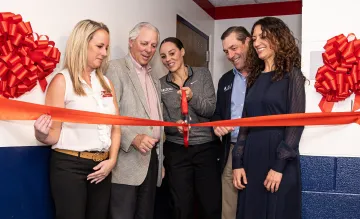
The University of Arizona and Arizona Athletics unveiled a new lactation room inside McKale Center in a ribbon-cutting ceremony that featured University President Dr. Robert C. Robbins, Director of Athletics Dave Heeke, Head Women's Basketball Coach Adia Barnes, and others as guest speakers.
Mike Christy | Arizona Athletics
In the News
ESPN Highlight Comments - Holly Rowe
KGUN - New lactation room opens at McKale Center
KOLD - University of Arizona cuts ribbon on private room at McKale for nursing mothers
UA@Work - Lactation spaces are 'a need – not a luxury'
The Daily Wildcat - UA initiative adds more campus lactation centers, including one in McKale
Arizona Athletics - McKale Center Official Grand Opening of First Lactation Room
New Lactation Space Locations
There are eleven new Tucson Main Campus lactation spaces including:
3 Mamava Lactation Pods
- Student Union Memorial Center
- University Services Building
- Highland Commons
7 New Lactation Rooms
- McKale Center
- Administration Building, Graduate College
- Campus Recreation - SouthREC
- CAPLA Building
- Kuiper Space Sciences Building
- Marley Building
- Modern Languages
- Psychology
5 new lactation rooms at sites around the state, including:
- La Paz County Cooperative Extension Office
- Glenn Curtis Building Yuma Agricultural Center
- Three lactation rooms at the University of Arizona - Phoenix Campus
All lactation space locations and access information can be found on the Life & Work Connections Family Resource Map. Mamava pods are accessed using the Mamava App.
All spaces are available on a first come, first serve basis, and all new spaces are ADA accessible.
New Lactation Spaces
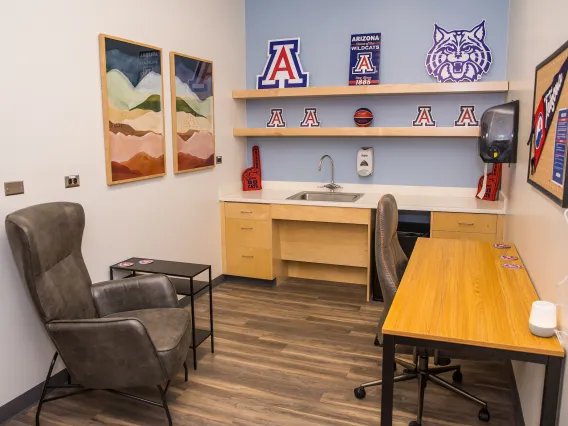
McKale
Photo by Mike Christy
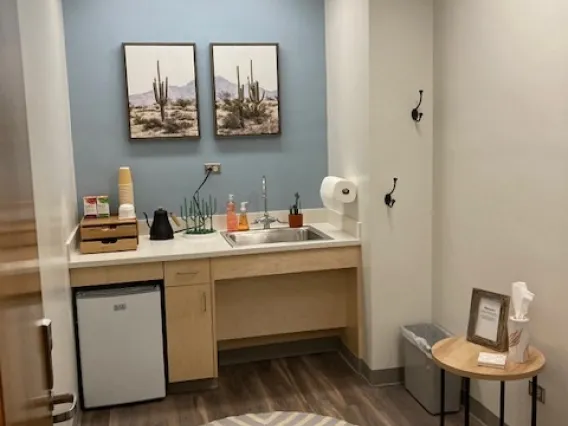
Psychology
Photo by Vincent Natale

SouthREC
Photo by Allison Giddings
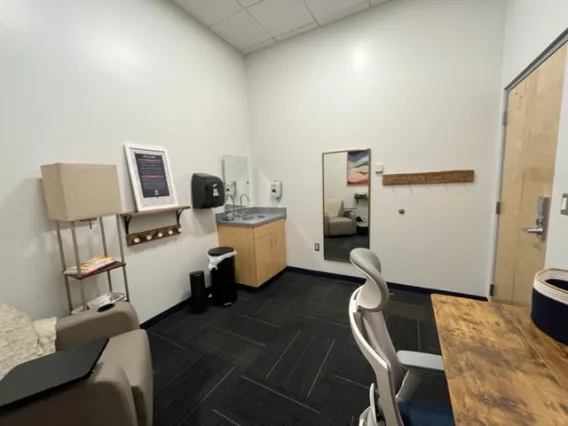
SouthREC
Photo by Allison Giddings
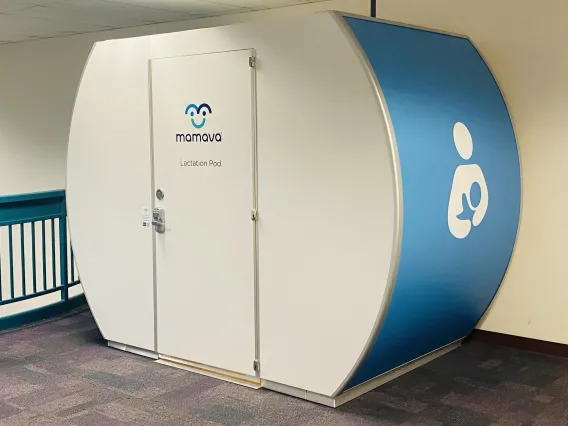
Mamava Lactation Pod in USB
Photo by Lori Van Buggenum
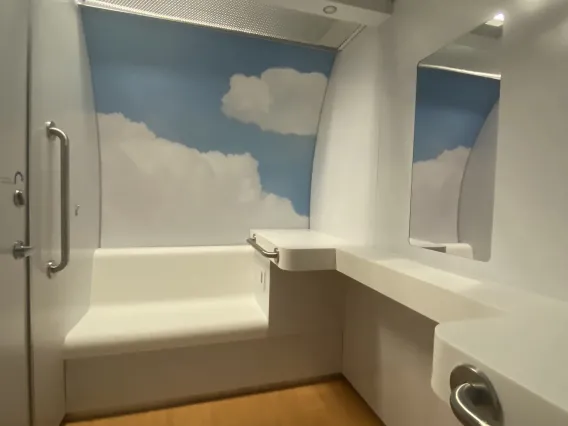
Inside the Mamava Lactation Pod in USB
Photo by Lori Van Buggenum
New Location Selection Process
Twenty-two applications for lactation space funding, including 12 requests from Tucson Main Campus units and 10 requests from other UArizona locations, were received after an institution-wide call for applications.
Applications were reviewed by a committee of diverse stakeholders, including student parents, faculty members, and subject matter experts from Life & Work Connections, Women & Gender Resource Center, Commission on the Status of Women, Mothers of Color in Academia, Facilities Management, Planning, Design & Construction, and Disability Resources.
All new lactation spaces are ADA accessible and fill in gap areas between existing lactation rooms on campus, particularly where there is high traffic flow of students, faculty, staff, and visitors.
Project Partners
Disability Resources
Facilities Management
Commission on the Status of Women
Life & Work Connections
Mothers of Color in Academia
Planning, Design & Construction
Women & Gender Resource Center
Project Contacts
Lori Van Buggenum, llv@arizona.edu
Amy Glicken, aglicken@arizona.edu
Frequently Asked Questions
A lactation space is a private room or pod where a nursing parent can go to pump milk for their baby. The American Academy of Pediatrics1 recommends that parents who choose to nurse their child do so for a full year, if possible. Yet for many nursing parents, parental leave ends before their babies are weaned, making it difficult to keep up milk production when they return to work. Lactation spaces provide a secure place for these employees to pump milk while at work or to nurse their child.
According to the CDC, “The longer an infant is breastfed, the greater the protection from certain illnesses and long-term diseases. The more months or years a woman breastfeeds (combined breastfeeding of all her children), the greater the benefits to her health as well.”2
Lactation spaces also provide a return on investment (ROI) in the form of reduced employee turnover, lower rates of absenteeism, and an increase in morale and productivity.3
Ensuring that there are lactation spaces for University employees, students, and visitors upholds the University’s commitment to being a family-friendly university.
1American Academy of Pediatrics. "Breastfeeding and the Use of Human Milk" Accessed on September 23, 2021.
2Center for Disease Control and Prevention. "Breastfeeding Frequently Asked Questions" Accessed on September 29, 2021.
3United States Breastfeeding Committee. "Workplace Accommodations to Support and Protect Breastfeeding," Click on Download the Document. Accessed on September 23, 2021.
View Life and Work Connections’ webpage on establishing lactation spaces.
The U.S. Department of Labor requires a space that is:
- Dedicated lactation space that is not a restroom and is not used for other purposes
- Located in a safe area that is accessible to all students, employees, and campus visitors
- Has a chair and work surface
- Clear signage with the international symbol for Breastfeeding
The University of Arizona Planning, Design, and Construction Office requires:
- Lockable door
- Electrical outlets
- Small utility-type sink or access to one nearby in a restroom or kitchen
- Storage for paper towels and wipes
- A minimum 7 feet by 7 feet footprint to allow for a 5-foot turning radius. Other measurement configurations may be acceptable pending an accessibility review.
- Sound privacy
- Small refrigerator or access to a refrigerator nearby
- WiFi access is helpful, but not required
Check the Family Resource Map for lactation spaces in your area. Filter the map by Lactation Space.
To report a new lactation space on campus, please complete the Family Friendly Resources Map form. In order to update or change information about an existing lactation space, please email Life & Work Connections at lifework@email.arizona.edu.
More information is available on the Life & Work Connections Family-Friendly Spaces page.
View the following resources with photos:
This Is What the Ultimate Office Pumping Room Looks Like & Why It Matters | Parents Magazine
The 20 Most Impressive Company Lactation Lounges in the U.S. | Working Mother
Ideally, lactation spaces will serve students, employees, and community members who are visiting campus.
Lactation rooms and pods should be ADA accessible. If there are building constraints, please consult with Eric Bell, Physical Access Consultant, with Disability Resources at ericbell@arizona.edu or 520-621-4955.
Lactation pods are modular units that provide a private space for a nursing parent to pump milk or nurse their child. Lactation pods can be placed in an open area such as a lobby or shared space.
Some lactation pod providers, such as Mamava, use an app that shows pod locations and availability.
Because the cost of lactation pods is higher, all potential office, lounge, study, storage, and other spaces should be explored before a pod is considered.
Currently, Mamava is the only approved lactation pod vendor for the University of Arizona. You are welcome to research other lactation pods, including BrighterBooth.
If you are interested in Mamava lactation pods, a great deal of information is on the Mamava website. Pods exist in Arizona at the Tucson Airport, Pima Air and Space Museum, Phoenix Airport, Gilbert Walmart, and Phoenix Suns Arena. View a map of all Mamava pods.
Benefits of Mamava pods:
- It can be difficult to find an available room or office to turn into a lactation room.
- Installation is quick and straightforward.
- Features include lighting and air flow.
- Parents use the Mamava cell phone app to find a pod, see if it is occupied, receive notification when it is vacant, leave feedback, and control the air flow, lighting, and music.
- Hospital grade Dupont Corian surfaces make the pods easy to clean.
- Pods are mobile. Each pod has retractable casters, so they can easily be moved within a space or can be taken down and reinstalled in a different space.
Please contact Sharyn Martin, Mamava representative, at sharynm@mamava.com or 502-216-1747, with any questions and to discuss your specific needs.

